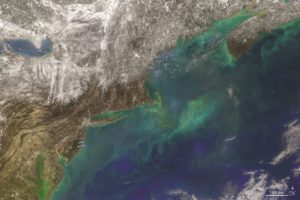The weather this past week — the temperatures remained cooler than usual and the winds howled — was not conducive to an improvement in fishing.
With the water temperature in the harbor at a frigid 46 degrees, I took a ride to look around and didn’t see many signs of life. Neither seals nor mackerel have arrived yet. Right whales are still around Race Point feeding on the enormous quantities of plankton that have bloomed. That’s what gives the ocean that wonderful aroma of fresh-cut melons you smell when you are by the water’s edge, by the way.
Striped bass seem to have stalled their migration to our south, but there are reports of a few keeper-size fish being taken around Martha’s Vineyard, which is somewhat encouraging.

One question I get asked a lot is “Early in the season, how can you tell if the first striper you catch is a migratory fish or a holdover fish that never left the area?” Well, the first way is by its size. Typically, only small, sexually immature fish remain in the area over the winter. In addition, because they hold over in brackish, muddy water, their colors aren’t usually vibrant — instead, they appear dull compared to migratory fish. The sure sign you have caught a migratory fish is the appearance of sea lice on the fish’s skin.
Sea lice are the most abundant parasites found on the bodies of striped bass caught in island and coastal waters. They are parasitic copepods — small invertebrates that are members of the plankton family. They appear as orange and brown spots and almost look like leeches, which, of course, they are not. And they do not affect the taste or quality of the fish at all. What do sea lice have to do with migration? These tiny creatures cannot live in brackish or fresh water, where holdover fish reside in the winter months. If the fish you catch in the spring has sea lice on it, then it is most certainly a migratory fish.
Lots of proposed changes to fishing regulations are being discussed lately at the National Marine Fisheries Service. Notable ones include a 16-inch minimum for commercially harvested bluefish; there is currently no limit. They’re also talking about reducing the recreational daily bag limit from 10 bluefish per person to five on boats for hire, with a three-fish bag limit for all others.
There is also an idea of limiting the number of mackerel allowed per day to somewhere between 10 and 20 fish per person (there is currently no limit). Scup minimum size may increase from 8 to 10 inches, and there is talk of closing all scup fishing in federal waters, which is moot, as hardly any commercial or recreational scup fishing occurs in federal waters. Striped bass commercial quotas will remain the same as in 2020-2021, but bluefish quotas have been increased slightly.
None of these proposals, in my opinion, really affects those of us who fish out of Provincetown and Truro. Our passengers do not typically catch more than five bluefish per day in a four-hour window.
This past weekend, the Cee-Jay tendered the two cruise ships that visited our port, and I have to say it’s hard to find a downside. You see most passengers carrying multiple bags of items purchased in the shops as they return to the ship, and you hear a lot of rave reviews about the lunches they had in the restaurants. This happening in April, when business is usually slow, seems like a win-win for tourists and businesses alike.
These ships will return in late October and early November, again bringing a welcome shot of revenue when business is otherwise a little soft.



